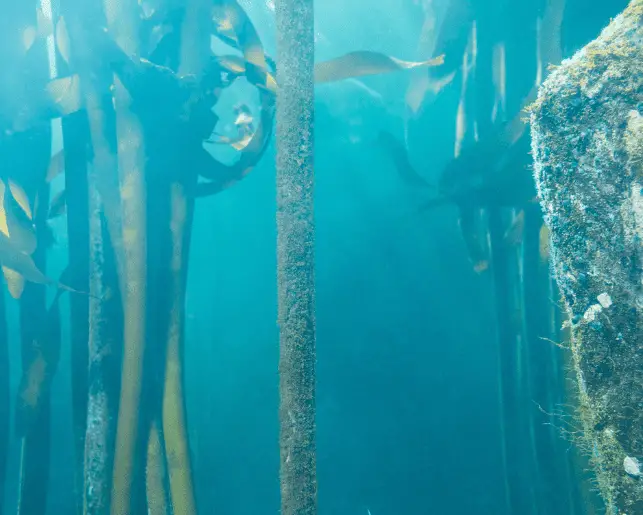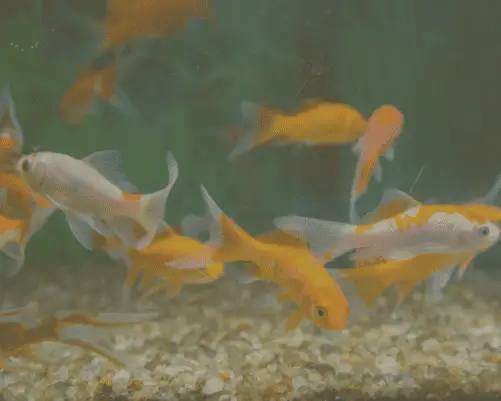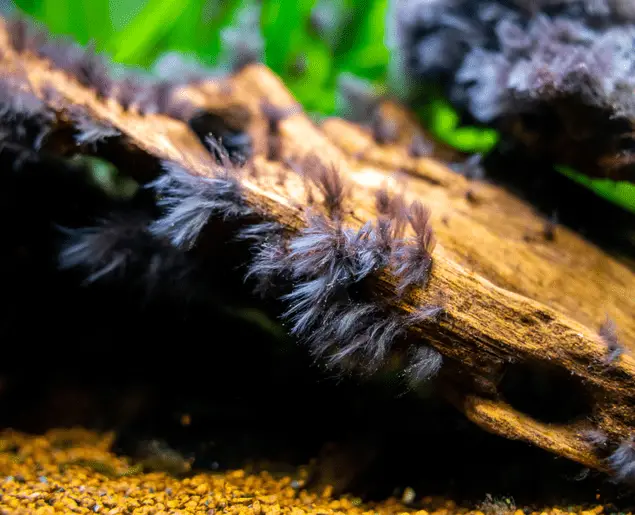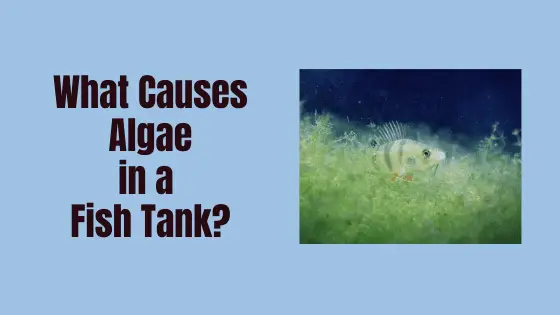Algae can be a hassle when you have a fish tank. But what factors make algae even harder to control than they must?
Light, excess nutrients like nitrogen and phosphorus, and low oxygen cause algae in a fish tank. Algae thrive when there’s full-spectrum, high-intensity, and long-duration light. Too many nutrients come from poor water circulation or lack of filter feeders.
What are algae, and what types are there in aquariums? How do you prevent those algae from taking over? Here’s what you need to know.
What Is Algae?
Algae refer to aquatic plants that can be as small as microscopic cyanobacteria to as large as 100 foot (30.48 m) kelp. They’re the basis that builds food webs, and they produce 70 percent of the world’s oxygen.
Algae grow in water depending on various nutrients, but seawater, wastewater, and water that receives agricultural runoff are their usual habitats. They live everywhere, including Antarctica, in geysers, mines, and highly acidic pollution.
Like other plants, algae use photosynthesis. Sunlight, CO2, nitrogen, and phosphorus are essential to their growth. Nitrogen and phosphorus are the most frequent nutrients cast from farms and other industrial areas. Some algae can also use carbohydrates around them and grow in the dark.
Algae can grow in water that other organisms don’t tolerate. These plants and bacteria can take over and get out of control, or they can clean the excess nutrients to the point that the water is hospitable to other plants and animals.
Different Types and Colours of Algae
Many types of algae receive their names from colours, and often they’re the colour they were named after. Common varieties are green algae, brown, red, and blue-green or the “cyan-” in cyanobacteria. Sometimes these refer to a species, but other times to categories. For example, black beard algae are within the red algae group.
Blue-Green Algae

Is blue-green algae alga, or is cyanobacteria a bacterium? Scientists once thought the organism was an alga and called them blue-green algae. After all, it’s green and photosynthesizes. Now we know that it’s a bacterium that happens to photosynthesize.
Either way, it has a role to play in an aquatic environment. Besides being the grass of the water world that everything eats, it also consumes nitrogen, fixing it to a different variety.
Red Slime Algae

Red slime algae are what they sound like, at least at first glance. They’re red and grow as a layer of slime on your glass and tank decorations. Yet, biologically, they’re cyanobacteria or blue-green algae. They’re bacteria that photosynthesize like true algae and other plants and readily grow in tanks with excess light.
Brown Algae

Brown algae are also diatoms, which are algae that integrate glass-like silicate into their structure. Like blue-green algae, they’re also photosynthetic. They also use nitrogen and phosphorus for their diet when they can’t use light and grow in both freshwater and saltwater tanks.
Black Beard Algae

Despite the black word in the name, black beard algae is a red alga that grows in marine environments. It also likes freshwater if the setup has tropical conditions. The dark colours of the alga come from the red light protein phycoerythrin, and it grows thick and with hairy, beard-like extensions on solid surfaces in the tank.
Green Spot Algae

The name of this algae accurately describes its appearance. It grows as green spots and has no qualms about coating everything in the fish tank, from the filter equipment to other aquatic plants. In a wild habitat, they would grow to the point of forming colonies. The alga doesn’t mind dense living as long as the environment meets its needs.
Is Algae Bad for Fish? How Do You Get Rid of Algae in a Fish Tank?
A small number of algae won’t be bad for fish, but they can get out of control and then cause harm. You can get rid of algae in a fish tank by changing the water, lighting, filtration, or picking fish that like to eat the types of algae your aquarium is prone to getting.
Blue-Green Algae
Over time, blue-green algae remove the nitrogen other organisms need in the water and take over in the form of dark slime.
Blue-green algae are common in aquariums. The limited space of the tank makes it easy for nitrogen and organic waste to alter the nutrients in the water, which will favor algae over fish. Light will also help the algae to grow.
Changing water more often and better circulation will balance the altered chemistry in your aquarium’s water.
Also, changing out old bulbs will help. The old ones provide too little light for the plants you want but enough for blue-green algae. If the algae are growing on the side of the tank most exposed to external lighting, then cover the tank for a few days. Adding in fast-growing plants will help to out-compete the algae.
Otherwise, apply Maracyn and Excel and remove the dead algae afterward.
Red Slime Algae
Red slime algae love excess nitrates and phosphate, which often come from poor water circulation. However, unlike many other algae, red slime likes poor lighting. You might find these algae if you have old bulbs that aren’t radiating as strongly as they used to or otherwise haven’t been keeping up with daily light routines.
Besides changing water, improving water circulation, or fixing filtration to remove excess nutrients, you can prevent growth by not over-feeding the fish. Uneaten food contributes to the nutrients dissolved in the water.
Fish and other aquarium creatures that eat red slime algae include blennies, tangs, crabs, sea urchins, and snails.
Brown Algae
Brown algae grow well in tanks that have low lighting and oxygen. They also love lots of nitrates, silicates, and phosphorus.
Filter feeders handle some of those issues, but young feeders may not be up to the task yet, and the algae take advantage. Once you have the algae, fish like Otocinclus catfish, Yellow tangs, and Plecostomus will be happy to munch on it.
As needed, you can get rid of brown algae by vacuuming and wiping it off any surface it’s growing on. Adequate light and water change are other basic options.
You may consider setting the filtration system to a gallons per hour rate higher than three. Also, you can use an air stone or lower the water temperature to increase the amount of oxygen dissolved in the water. A reverse osmosis system may be worth the investment.
Black Beard Algae
Black beard algae often present themselves in new setups when you are still balancing the chemistry and physics of the aquarium. Too much light and too little of everything else like nutrients, CO2, and circulation will kick-start their growth.
Because algae like to attach to solid surfaces, wiping down these objects removes much of them. Some items have irregular surfaces that are hard to wipe, but you can remove them. Place those in a bleach solution of one part bleach and 20 parts water for three minutes to get rid of the rest.
Otherwise, make sure to change your water frequently. Also, if you have more CO2, you can grow the plants you want faster, and those will pick up the nutrients before algae can.
You can add Siamese algae eaters, Amano shrimp, or Florida flag fish to predate on the algae.

Green Spot Algae
Green spot algae behave a lot like Black beard algae. They favor low phosphate and fertilization levels, among the other typical algae-growing circumstances like poor water circulation and too much light.
Because of their sensitivity to phosphate levels, injecting the water with phosphorus will curb growth. Also, most aquarium plants only need nine hours of light, so dial back on the lighting if your tank is getting more than that.
Sun snails of the Clithon genus and Nerite snails of the Neritina genus eat green spot algae.
Do LED Lights Cause More Algae in a Fish Tank?
LED lights have become popular aquarium lights. They have longer lives, require less energy, and heat the surrounding area less than other lights. Many also have adjustable brightness to accommodate different situations and fish.
LED lights don’t cause more algae in a fish tank. Algae respond to light intensity, spectrum, light color, and duration, not strictly the type of light. So LED lights don’t cause growth more than any other light at the same brightness, color temperature, and time frame.
The difference comes from LED’s slightly less intensity and lack of recreating the sunlight spectrum. Both of these factors mean LEDs cause less algal growth.
Final Thoughts
Algae can grow aggressively in fish tanks with the right conditions. Inverting these conditions will enable you to control the growth.
Algae favour long exposure to intense and spectrum light. This preference is regardless of the type, like LED or fluorescent. If you have poor water circulation and oxygen levels, lack filter feeders, or lack algae-eating fish, the algae will also consume the excess nutrients loitering in the tank.
My advice is to add a few snails to your tank. I have 2 Red Spotted Nerite Snails and I absolutely love them!

They are my clean-up team! I have some imitation plants in my tank and algae has started to appear on the leaves which I haven’t been able to scrub off. Bill and Ben, my snails, now keep them spotless for me!

